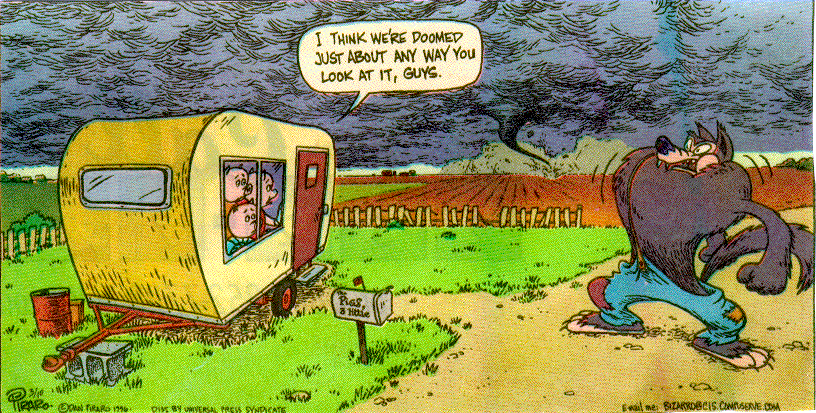

We have all experienced the darkening skies and sheets of rain that accompany thunderstorms. Flashes of lightning and blinding rain are cliché in horror films to signal some diabolical deed. In addition to monsters, thunderstorm hazards include lightning, hail, tornadoes, downbursts, torrential rains and flooding. Weather associated with thunderstorms may have a significant impact on the environment: flooding may result in severe soil erosion and lightning strikes may start large fires.
The satellite view of a thunderstorm is demonstrated in a GOES-8 satellite 1 minute loop of a storm over Oklahoma. This loop is from the home page of Dr. Chesters at NASA Goddard.
The air mass thunderstorm is common in Florida. As with all thunderstorms, it contains thunder and therefore has lightning. The air mass thunderstorm lasts approximately one hour and has a very distinctive life cycle.
Cumulus Stage: Rising air, or updraft, cools and forms the cloud. The rising air is occurring in an environment that is favorable for convection. Lifting mechanism include solar heating or convergence from a sea breeze. It is not raining during this stage of the thunderstorm.
Mature Stage: As the cloud continues to grow, precipitation particles form and fall from the cloud. The precipitation falls into the updraft. The falling particles drag air down with them. This sinking air is referred to as downdrafts. Entrainment into the downdraft results in some evaporation of the precipitation, which causes a cooling which makes the air more dense, thus increasing the downdraft. Rain begins to reach the surface. Hail may also make it to the surface, but they are not very large.
Dissipating Stage: When the downdrafts encompass the storm, the updrafts are shut off and the storm begins to die. The intensity of the rain decreases.
Prior to the development of a thunderstorm, the air near the surface is often warm and moist. With the downdrafts come cool air and the temperature at the surface drops. After the storm passes, the temperature may begin to rise again.
In the air mass thunderstorm the precipitation falls into the updraft, cutting off the storm's moisture supply and eventually kills itself. The air mass thunderstorm only lasts about an hour which is not enough time to produce severe weather. In the Severe thunderstorm the updrafts and downdrafts are separate from one another, This allows the storm to last longer and severe weather may develop. To separate the updraft from the downdraft requires wind shear.
Winds speed increase with altitude case to updraft to tilt. Because it tilts, when precipitation falls, it does not fall into the updraft, thus allowing a continuous source of moist warm air to fuel the storm. In addition to the winds increasing with altitude, the wind direction also changes. Enormous severe storms that develop and have a tilted updraft are called supercell thunderstorms.
Below are some animations of the updraft and downdrafts in a supercell thunderstorm. As you view these animations keep track of the following features: The overshooting top, the cirrus anvil, the updrafts (yellow lines) and a downdraft (green lines).
Side-view animation of the updrafts and downdrafts of a severe thunderstorm.
Another animation , from a different perspective, of the updrafts and downdrafts in a severe thunderstorm.

Hail: Though being killed by getting hit by a hail storm is rare, you should seek protection from large hail. You are safe inside your car.
Flooding: There are a variety of ways that flooding can occur. The best thing to do in the case of flooding is seek higher ground.
Tornado: In many states, when tornadoes are in the area warnings are issued over the radio and tv stations and with sirens. You should seek shelter in the basemant of a building or in a small interior room such as a closest. DO NOT waste your time opening your windows, this will not protect your house and will only place you in possible danger due to flying debre.
If you are in a mobile home, get out and lie down in a low lying area
Lightning: In the US, lightning kills on average, nearly 80 people a year. So treat the threat seriously. Don't stand under a lone tree or out in an open field. You are safe inside your car. If you are on a lake, get off. If you are caught in an open field it is best to crouch down.
If someone near you gets struck by lightning you may be able to revive them if you know CPR. While it is unlikely that you, or someone you know will get struck, it is a good idea to know CPR.
In the Middle Ages, people though that you could keep lightning away by ringing church bells. Is this a good idea?
If you are in a sail boat in the middle of a large lake during a thunderstomr, the mast could attract a lightning strike. Sailors would wrap one end of a metal chain around the base of the mast, and put the other end in the water. How would this protect them?
Why is knowing the condition of the soil important for predicting flooding?
Why are tornado warning sirens so loud and piercing?
Why are thunderstorms in the US most common in Florida, yet the tornadoes are more common in Oklahoma and Kansas?
Why are wind speeds around tornadoes so strong?